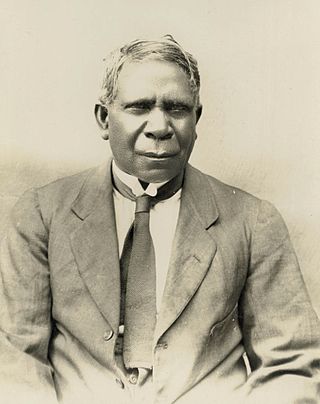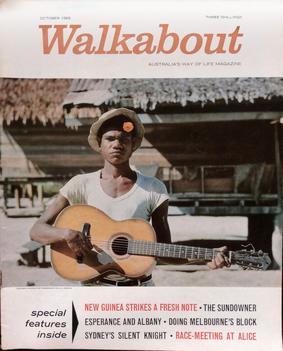
Australian art is any art made in or about Australia, or by Australians overseas, from prehistoric times to the present. This includes Aboriginal, Colonial, Landscape, Atelier, early-twentieth-century painters, print makers, photographers, and sculptors influenced by European modernism, Contemporary art. The visual arts have a long history in Australia, with evidence of Aboriginal art dating back at least 30,000 years. Australia has produced many notable artists of both Western and Indigenous Australian schools, including the late-19th-century Heidelberg School plein air painters, the Antipodeans, the Central Australian Hermannsburg School watercolourists, the Western Desert Art Movement and coeval examples of well-known High modernism and Postmodern art.

David Ngunaitponi, known as David Unaipon, was an Aboriginal Australian preacher, inventor and author. He was a Ngarrindjeri. Unaipon's contribution to Australian society helped to break many Aboriginal Australian stereotypes, and he is featured on the Australian $50 note in commemoration of his work. He was the son of preacher and writer James Unaipon.

Kathleen Kylie Tennant AO was an Australian novelist, playwright, short-story writer, critic, biographer, and historian.

The Jindyworobak Movement was an Australian literary movement of the 1930s and 1940s whose white members, mostly poets, sought to contribute to a uniquely Australian culture through the integration of Indigenous Australian subjects, language and mythology. The movement's stated aim was to "free Australian art from whatever alien influences trammel it" and create works based on an engagement with the Australian landscape and an "understanding of Australia's history and traditions, primeval, colonial and modern".

Makassar people from the region of Sulawesi in Indonesia began visiting the coast of Northern Australia sometime around the middle of the 18th century, first in the Kimberley region, and some decades later in Arnhem Land. They were men who collected and processed trepang, a marine invertebrate prized for its culinary value generally and for its supposed medicinal properties in Chinese markets. The term Makassan is generally used to apply to all the trepangers who came to Australia.
Angus & Robertson (A&R) is a major Australian bookseller, publisher and printer. As book publishers, A&R has contributed substantially to the promotion and development of Australian literature. This well known Australian brand currently exists as an online shop owned by online bookseller Booktopia. The Angus & Robertson imprint is still seen in books published by HarperCollins, a News Corporation company.

The Aborigines Progressive Association (APA) was an Aboriginal Australian rights organisation in New South Wales that was founded and run by William Ferguson and Jack Patten from 1937 to 1944, and was then revived from 1963 until around 1970 by Herbert Groves.

Capricornia (1938) is the debut novel by Xavier Herbert.

Walkabout was an Australian illustrated magazine published from 1934 to 1974 combining cultural, geographic, and scientific content with travel literature. Initially a travel magazine, in its forty-year run it featured a popular mix of articles by travellers, officials, residents, journalists, naturalists, anthropologists and novelists, illustrated by Australian photojournalists. Its title derived "from the supposed 'racial characteristic of the Australian Aboriginal who is always on the move'."

Ion Llewellyn Idriess was a prolific and influential Australian author. He wrote more than 50 books over 43 years between 1927 and 1969 – an average of one book every 10 months, and twice published three books in one year. His first book was Madman's Island, published in 1927 at the age of 38, and his last was written at the age of 79. Called Challenge of the North, it told of Idriess's ideas for developing the north of Australia.
Charles Duguid was a Scottish-born medical practitioner, social reformer, Presbyterian lay leader and Aboriginal rights campaigner who lived in Adelaide, South Australia for most of his adult life, and recorded his experience working among the Aboriginal Australians in a number of books. He founded the Ernabella mission station in the far north of South Australia. The Pitjantjatjara people gave him the honorific Tjilpi, meaning "respected old man". He and his wife Phyllis Duguid, also an Aboriginal rights campaigner as well as women's rights activist, led much of the work on improving the lives of Aboriginal people in South Australia in the mid-twentieth century.
Jeff Carter was an Australian photographer, filmmaker and author. His work was widely published and contributed iconic representation of the working population of the Australian bush as self-sufficient rugged and laconic.
Colin Thomas Johnson, better known by his nom de plume Mudrooroo, was a novelist, poet, essayist and playwright. He has been described as one of the most enigmatic literary figures of Australia and his many works are centred on Australian Aboriginal characters and Aboriginal topics.
In February 1948, a team of Australian and American researchers and support staff came together in northern Australia to begin, what was then, one of the largest scientific expeditions ever to have taken place in Australia—the American-Australian Scientific Expedition to Arnhem Land. Today it remains one of the most significant, most ambitious and least understood expeditions ever mounted.

Destiny in Sydney: An epic novel of convicts, Aborigines, and Chinese embroiled in the birth of Sydney, Australia is the first historical novel in a three-book series about Sydney, Australia, by American writer D. Manning Richards. It was published in 2012 and followed by the second serial book, Gift of Sydney, in 2014. Destiny in Sydney begins in 1787 in Scotland and ends in 1902, covering 126 years of Australian history. The family saga story follows three fictional families: Scots-Irish, Aboriginal, and Chinese, who interact with real-life historical figures to dramatize the major events and conflicts in Australian history. Richards writes “The history is largely accurate. .. based on recorded history. .. from well over two hundred sources.” The appendix lists ninety primary references and includes a discussion of “Fact or Fiction?” by chapter that tries to anticipate readers’ questions.
Phyllis Evelyn Duguid, née Lade, was an Australian teacher and Aboriginal rights and women's activist, who was highly regarded for her long-term commitment to those she saw as members of an underclass in society. She was married to, and often worked alongside, Charles Duguid, medical practitioner and Aboriginal rights campaigner, the couple leading much of the work on improving the lives of Aboriginal people in South Australia in the mid-twentieth century. She founded the League for the Protection and Advancement of Aboriginal and Half-Caste Women, which later became the Aborigines' Advancement League of South Australia (AALSA).
There were five main arenas where Australian Great War Poetry was written in the period of 1914 to 1939: the Home Front, Gallipoli, The Middle East, The Western Front and England. These arenas were to form important segregations of poetic attitude and interest specific to the war mood at the time. Australian poets, just like their British counterparts, could be humorous, melancholy, angry or just longing for home. Many Australians, for example, wrote about the Australian flora, and how they missed it.
Gillian Cowlishaw is a New Zealand-born anthropologist whose ethnographic research with Aboriginal Australians, investigates local cultures, histories and the relationship between settler colonialists and Indigenous people.

Edwin Colin Simpson, known professionally by his pen name Colin Simpson, was an Australian journalist, author and traveller. After a successful career as a journalist with Sydney newspapers and a writer of radio documentaries for the Australian Broadcasting Commission, he became a freelance writer of "popular travel books" which sold more than half a million copies. He was "instrumental in securing the Public Lending Right legislation" for Australian authors.
The Aboriginal-Australian Fellowship (AAF) was a Sydney-based organisation focused on changing the New South Wales Aborigines Protection Board, the wider issues of wage parity and full citizenship for Aboriginal Australians.